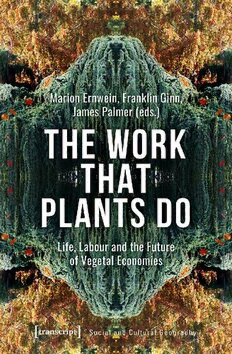
The Work That Plants Do: Life, Labour and the Future of Vegetal Economies PDF
Preview The Work That Plants Do: Life, Labour and the Future of Vegetal Economies
Marion Ernwein, Franklin Ginn, James Palmer (eds.) The Work That Plants Do Social and Cultural Geography | Volume 45 Marion Ernwein is a lecturer in environmental geography at the Open University. She researches the changing place of plants in contemporary urbanism. Franklin Ginn is a senior lecturer in cultural geography at the University of Bris- tol. He is author of Domestic wild: Memory, nature and gardening in suburbia, and co- editor of Environmental Humanities. James Palmer is a lecturer in environmental governance at the University of Bris- tol. His research examines resource-making practices associated with new bio- energy economies and infrastructures. Marion Ernwein, Franklin Ginn, James Palmer (eds.) The Work That Plants Do Life, Labour and the Future of Vegetal Economies Bibliographic information published by the Deutsche Nationalbibliothek The Deutsche Nationalbibliothek lists this publication in the Deutsche National- bibliografie; detailed bibliographic data are available in the Internet at http:// dnb.d-nb.de © 2021 transcript Verlag, Bielefeld All rights reserved. No part of this book may be reprinted or reproduced or utili- zed in any form or by any electronic, mechanical, or other means, now known or hereafter invented, including photocopying and recording, or in any information storage or retrieval system, without permission in writing from the publisher. Cover layout: Maria Arndt, Bielefeld Cover illustration: Jean-Jacques Kissling, jjkphoto.ch Printed by docupoint GmbH, Magdeburg Print-ISBN 978-3-8376-5534-6 PDF-ISBN 978-3-8394-5534-0 https://doi.org/10.14361/9783839455340 ISSN of series: 2703-1640 eISSN of series: 2703-1659 Printed on permanent acid-free text paper. Contents Acknowledgements.................................................................. 7 Authorbiographies .................................................................. 9 ListofFigures....................................................................... 13 Introduction:Theworkthatplantsdo MarionErnwein,JamesPalmer,FranklinGinn..............................................15 SECTION I Planty commodities Chapter1-Whoseperformance? AgenciesinJapaneseornamentalhorticulture EmilieLetouzey..........................................................................35 Chapter2-Careforthecommodity? The work of saving succulents in the laboratory JaredMargulies..........................................................................53 Chapter3-PlantingSoftPakistan FranklinGinn&DaanishMustafa ..........................................................71 SECTION II Vegetal Labour Chapter4-Ecologiesofactor-networksand (non)social labor within the urbanpoliticaleconomiesof nature HaroldPerkins........................................................................... 87 Chapter5-Plantlabourintheecological regime of urban maintenance:Reproduction, collaboration, uneven relations MarionErnwein ......................................................................... 105 Chapter6-Vegetallabourandthemeasureofvalue: Reckoningtimeandproducingworthin capitalist viticulture JeremyBrice............................................................................ 123 SECTION III Future-making with plants Chapter7-Shadywork: Africanmahogany(Khayasenegalensis),cyclonesandgreenurban futuresinDarwin,Australia JenniferAtchison....................................................................... 149 Chapter8-Forestfuels: Vegetallabourandthereinventionof working forests as carbon conveyorsin the USSouth JamesPalmer .......................................................................... 163 Chapter9-Latentcapital: Seedbankingasinvestmentinclimatechangefutures CanDalyan...............................................................................181 Bibliography......................................................................... 193 Acknowledgements Theideaforthisbookfirstemergedatthe2018AnnualMeetingoftheAmerican AssociationofGeographers,inNewOrleans.Itwastheproductofconversations between what would become the editors and several of the contributors during andaroundsessionscentredonvegetalgeographies.Thebookprojectfurtherde- veloped through additional conversations at the 2019 edition of the meeting, in Washington,D.C.Manyofourgreathopesforthebook–forittobethefruitofa trulycollaborativewritingprocess,inclusiveofaworkshopandamutualpeer-re- viewingprocess–hadtobere-evaluatedinlightoftheCovid-19pandemic,which hitusatthestartof2020,andisstillwithusaswewritethisinApril2021.The workshopnevertookplace,someofthecontributorswereforcedoutoftheproject bytheirincreasedcarecommitments,andthepaceofwriting,reviewingandre- vising chapters was affected.We thank wholeheartedly all of our contributors – thosewhosechaptersfigureinthebook,andthosewhosepotentialcontribution remainsaghostlypresence–forthetimetheyhavemadeforthisproject,fortheir generosity,and for the care they have put into reading and engaging with each other’s work.At transcript,we wish to thank Jakob Horstmann for his enthusi- asm,guidanceandperhapsaboveanythinghispatiencethroughoutthelifeofthis book,andAnnikaLinnemannformakingtheproductionsuchasmooth,seamless process.Finally,wealsothankallthosewithwhomwe’veenjoyednonhumanlabour conversationsanddebatesovertheyearsateventsfromIslamabadtoWashington, Aarhus,andmanyplacesin-between. Author biographies JenniferAtchisonlivesandworksinDharawalCountry.SheisSeniorLecturerin theSchoolofGeographyandSustainableCommunities,UniversityofWollongong, andanAustralianResearchCouncilFutureFellow,awarded2020.Shehasapas- sionforplantsandamultidisciplinarybackgroundinenvironmentalscienceand archaeobotany. Her current research seeks to understand the place of plants in past,present and future lives and how life is responding and adjusting to rapid environmentalchange.Shehashadtheprivilegeoflearningaboutpeople,plants andenvironmentalchangeinGadjerongCountry. JeremyBriceisaPostdoctoralResearcherattheUniversityofOxfordandVisiting FellowinEconomicSociologyatLSE.InOxford,hisresearchexaminestheroleof sustainability,biosecurityandanimalwelfaremetricsinreconfiguringbothpublic debatesoverandthegovernanceofintensivemeatproduction.Jeremy’sdoctoral workinvestigatedtheeconomicandenvironmentaltransformationsengendered bytheAustralianwineindustry’sreorientationtowardstheproductionof‘wines fromsomewhere’,examininghowchanginglogicsofevaluationandaccumulation intersectwithattachmentstoplacetogeneratecontrastingpoliticaleconomiesand ecologiesofquality.Morerecentresearchprojectshavefocusedontheanticipation ofcrisisandthegovernanceofriskwithintransnationalfoodsupplynetworksand ontheroleofdigitalmarketplaceplatformsinreconfiguringurbaneconomiesand culturesoffoodconsumptionintheUK. CanDalyanisanAssistantProfessorofAnthropologyattheCollegeofCharleston. Hisfirstbookproject, Life,Arrested:GenebankingandtheBiopoliticsofClimateChange inTurkey,drawsonmulti-yearethnographicfieldworkinTurkeyandanalyzesthe managementoflatentplantlifeinsidethecountry’sfirstnationalseedbankinjux- tapositionwithbiopoliticalprojectsthatseektoarrestsociallifesuchasextended emergencyrule,refugeecamps,andshelter-in-placeregulations.Hissecondlong- termproject,basedinCharleston,SC,exploresclimateadaptationwithinthecon- textofsealevelrise,floodingpreparedness,andrealestatespeculation.
